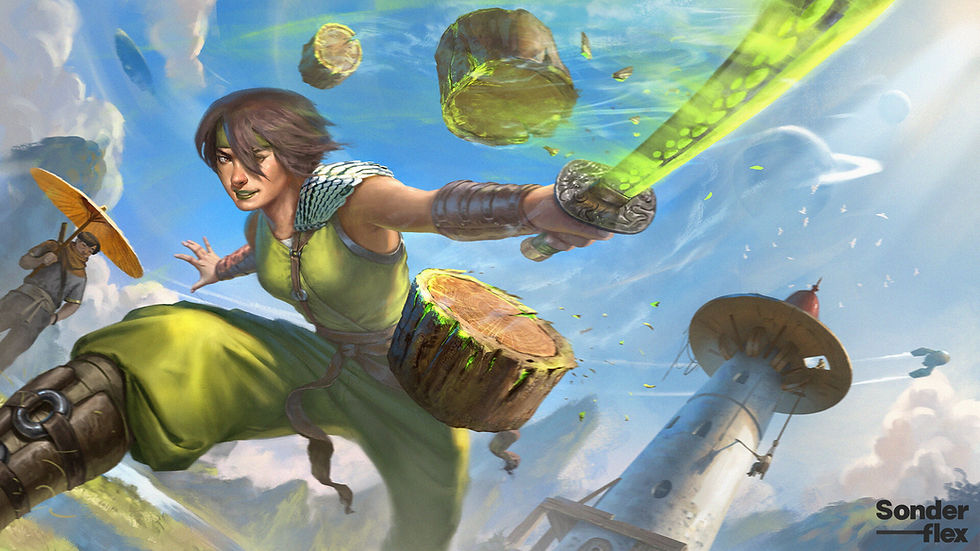How 2D Art Elevates the Immersive Experience of 3D Games?
- Sonderflex Studio
- May 8, 2024
- 3 min read
Updated: May 29, 2024

In the world of game development, how can developers enhance the immersive gaming experience or strengthen the characters and outcomes of their games?
It'd be a shame if the games they create aren't enjoyed to the fullest or end up feeling just like any other game out there!
But worry not! Before you throw in the towel on developing that dream game, let's start crafting solutions by looking at some crucial factors in game development. One of those factors is visual style!
Did you know that 2D visual style can be blended into 3D games to create something more captivating and unique?
In this article, we'll delve into the potential and benefits of integrating 2D visual assets into 3D games!
Exploring the Fusion of 2D Visual Style and 3D Games
The practice of integrating 2D visual style into 3D games has been around since the early days of game development.
This integration solution was employed by game developers to work around hardware limitations that couldn't quite produce realistic 3D game models.
But it's not just about that. Even though the trend in today's gaming leans heavily towards realistic and 3D styles, the power and allure of 2D visual style cannot be dismissed outright.
In fact, with rapid technological advancements, 2D visual style can be a key factor in enhancing the quality of 3D games.
The evolution of both has paved the way for integrations like using 2D sprites within 3D spaces.
Benefits of Combining 2D and 3D Styles in Games
Blending 2D visual style into 3D games brings about numerous benefits that can enhance the appeal and gaming experience. Here are some advantages to consider:
Varied Aesthetics and Artistry
Combining 2D and 3D styles is like taking the best from both worlds, resulting in more engaging and diverse artistic outcomes. For instance, 3D can be utilized to create dynamic movement spaces and complex scenes, while 2D elements add unique touches and details not achievable through 3D alone.
Effective Performance Optimization
In video game development, integrating 2D assets into 3D space can lead to more efficient performance. Typically, 2D assets are less resource-intensive compared to 3D models.
Nostalgic Appeal
For many players, the 2D visual style ignites nostalgic feelings. Memories of playing classic games or watching 2D animations keep its appeal evergreen. Integrating 2D elements with modern 3D visuals creates a retro vibe while offering an immersive experience.
Bridging Two Worlds: Maximizing 2D Integration for 3D Gaming Experience
Integrating 2D visual style and assets into 3D games requires strategic planning and sound technical decisions. Here are some key points to note:
Concept Design and Planning Phase
This phase requires creative direction that's not only precise but also consistent. Decisions should align with the game's narrative, aesthetic goals, target audience, and platform capabilities.
Asset Creation
While a 2D artist creates assets using digital painting, vector graphics, or traditional drawing methods, simultaneously, a 3D artist designs movement spaces and environments that will later be integrated with the 2D assets.
Integration Into the Engine
Both 2D and 3D assets are imported into the game using software like Unity or Unreal Engine. It's crucial to ensure compatibility and optimization with the rendering system during this phase.
Testing and Iteration
Continuous testing is crucial to ensure that each asset functions properly. Integrating 2D assets with 3D can impact a game's performance.
Examples of Captivating 2D Visual Style in Famous 3D Games
When developing a video game, it's beneficial to examine various games for reference. Combining 2D visual style with captivating 3D games isn't easy, so let's take a look at some popular games that blend 2D and 3D visual styles:
Paper Mario Series
Published by Nintendo, this series blends 2D assets with captivating 3D spaces. The "Paper-Like" 2D visual style of characters and objects adds a strong allure to the game.
Don’t Starve
Developed by Klei Entertainment, Don’t Starve seamlessly integrates hand-drawn 2D character and object assets into a 3D environment, offering a unique gaming experience.
Hollow Knight
Developed by Team Cherry, this game effectively uses detailed 2D assets and backgrounds in a 3D world. The intricate 2D visual style creates a dark and atmospheric ambiance in Hollow Knight.
Conclusion: 2D Visual Style Enhances Unforgettable 3D Gaming Experience
In the ever-evolving gaming world, the role of 2D visual style in enhancing 3D gaming experiences has become increasingly significant.
By intelligently combining these elements, game developers can create deeper and more captivating experiences for players.
Through gameplay optimization, rich atmosphere creation, and intuitive interface design, the synergy between 2D and 3D offers limitless creative potential.
Of course, executing a plan to integrate 2D assets into 3D games requires professional resources.
One such resource is Sonderflex Studio. With a professional portfolio spanning from 2D visual asset creation to integration into 3D, Sonderflex Studio can be the solution for the creative decisions of your current or upcoming game!


